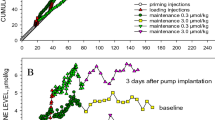Abstract
The present study was undertaken to evaluate the effects of single and repeated doses of triazolam (1 mg/kg IP) and desipramine (DMI) (10 mg/kg PI) alone and in combination on certain pharmacologic responses and brain catecholamine levels in rats. The significant findings were: (1) triazolam and DMI given alone and in combination were synergistic with pentobarbital (PB) hypnosis; (2) repeated treatment with DMI alone repressed body weight gain; triazolam potentiated this anorectic effect; (3) triazolam induced muscle relaxation acutely, but was not affected by concomitant DMI treatment; and (4) triazolam and DMI given in combination produced hypothermia although the drugs given separately did not. Development of tolerance to hypothermia and to anorectic effects produced by triazolam and DMI significantly decreased norepinephrine (NE) levels in the hypothalamus as compared to the repeated treatment with triazolam, and significantly increased NE and dopamine (DA) levels in the striatum and DA levels in the cortex, as compared to the single treatments.
Similar content being viewed by others
References
Alpers HS, Himwich HE (1972) The effects of chronic imipramine administration on rat brain levels of serotonin, 5-hydroxyindoleacetic acid, norepinephrine and dopamine. J Pharmacol Exp Ther 180:531–538
Anton AH, Sayre DF (1964) The distribution of dopamine and dopa in various animals and a method for their determination in diverse biological material. J Pharmacol Exp Ther 145:326–336
Bartholini G, Keller H, Pieri L, Pletscher A (1973) The effect of diazepam on the turnover of cerebral dopamine. In: The benzodiazepines. Raven Press, New York, p 235
Byck R (1975) Drugs and the treatment of psychiatric disorders. In: Goodman LS, Gilman A (eds) The pharmacological basis of therapeutics. 5th edn. Macmillan, New York, p 152
Dahlström A, Fuxe K (1964) Evidence for the existence of monoamine-containing neurons in the central nervous system. Acta Physiol Scand 62:suppl. 232, 1–55
Eberts FS (1977) Disposition of triazolam, 8-chloro-6-(o-chlorophenyl)-1-methyl-4H-s-triazolo[4,3-α] [1,4] benzodiazepine, in the dog. Drug Metab Dispos 5:547–555
Furukawa T, Yamasaki M, Hiraga Y, Fukazawa E, Soejima S (1975) Pharmacodynamic effects of triazolam. Igaku Kenkyu (Acta Medica) 45:285–301
Glassman AH, Perel JM (1973) The clinical pharmacology of imipramine. Arch. Gen Psychiatry 28:649–653
Glowinski J, Iversen LL (1966) Regional studies of catecholamines in the rat brain. The disposition of 3H norepinephrine, 3H dopamine and 3H dopa in various regions of the brain. J Neurochem 13:655–669
Goldberg ME, Manian AA, Efron DH (1967) A comparative study of certain pharmacologic responses following acute and chronic administrations of chlordiazepoxide. Life Sci 6:481–491
Hartmann E, Cravens J (1973) The effects of long term administration of psychotropic drugs on human sleep. The effects of chlordiazepoxide. Psychopharmacology 33:233–245
Hashimoto H, Maruyama Y (1978) Development of an electrochemical detector for high-performance liquid chromatographic assay of brain catecholamines. J Chromatogr 152:387–393
Johnson GA, Kim EG, Boukma SJ (1971) 6-Phenyl-4H-s-triazolo (4,3-α) (1,4) benzodiazepines; effect upon catecholamines in rat brain stem. Pharmacologist 13:234
Kato R, Chiesara E, Vassanelli P (1963) Mechanism of potentiation of barbiturates and meprobamate actions by imipramine. Biochem Pharmacol 12:357–364
Kimishima K, Tanabe K, Kinoshita Y, Tamaki H, Kawamura M, Kurihara A (1976) Central nervous action of triazolam, a new benzodiazepine derivative. J Yonago Med Assoc 27:314–323
Kitagawa H, Esumi Y, Kurosawa S, Sekine S, Yokoshima T (1979) Metabolism of 8-chloro-6-(o-chlorophenyl)-1-methyl-4H-s-triazolo [4,3,-α] [1,4] benzodiazepine, triazolam, a new central depressant. Identification and determination of metabolites in rats and dogs. Xenobiotica 9(7):429–439
Liu S, Huang CL, Waters IW (1975) Interactions of tricyclic antidepressants and barbiturates in barbiturate-tolerant and non-tolerant rats. J Pharmacol Exp Ther 194:285–295
Maruyama Y, Kusaka M (1978) Assay of norepinephrine and dopamine in the rat brain after microwave irradiation. Life Sci 23(15):1603–1608
Refshauge C, Kissinger PT, Dreiling R, Blank L, Freeman R, Adams RN (1974) New high performance liquid chromatographic analysis of brain catecholamines. Life Sci 14:311–322
Roffler-Tarlov S, Schildkraut JJ, Draskoczy PR (1973) Effects of acute and chronic administration of demethylimipramine on the content of norepinephrine and other monoamines in the rat brain. Biochem Pharmacol 22:2923–2926
Rosloff BN, Davis JM (1978) Decrease in brain NE turnover after chronic DMI treatment; no effect with iprindole. Psychopharmacology 56:335–341
Rudzik AD, Hester JB, Tang AH, Straw RN, Frücn W (1973) Triazolobenzodiazepines, a new class of central nervous system-depressant coumpounds. In: The benzodiazepines. Raven Press, New York, p 285
Schildraut JJ, Winokur A, Applegate CW (1970) Norepinephrine turnover and metabolism in rat brain after long-term administration of imipramine. Science 168:867–869
Tabakoff B, Yanai J, Ritzman RF (1978) Brain noradrenergic systems as a prerequisite for developing tolerance to barbiturates. Science 200:449–451
Turner RA (1965) Inclined plane test. In: Screening methods in pharmacology. Academic Press, New York, p 75
Author information
Authors and Affiliations
Rights and permissions
About this article
Cite this article
Kusaka, M., Horikawa, A., Meshi, T. et al. Interaction of triazolam with desipramine. Psychopharmacology 70, 255–261 (1980). https://doi.org/10.1007/BF00427882
Received:
Accepted:
Issue Date:
DOI: https://doi.org/10.1007/BF00427882



